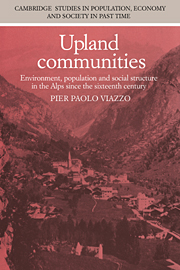 Upland Communities
Upland Communities Published online by Cambridge University Press: 13 October 2009
In 1980 Alan Macfarlane remarked that it was ‘a pleasing irony that one of the “hardest” of the social sciences, concerned with the analysis of numbers of births, marriages and deaths, should be nudging us towards that realization of the importance of “culture” which, so some have argued, is the special contribution of anthropology’. Recent research in historical demography had in fact demonstrated the existence in pre-industrial Europe of broad regional differences in demographic systems and family structures, and ‘looking from a very long distance’ one could not help being struck by the association between the cultural and ethnic subdivisions of traditional Europe and the demographic map which was gradually emerging. It seemed more than a pure coincidence, to Macfarlane, that the boundary between western and eastern European marriage patterns detected by Hajnal roughly followed the Slav/non-Slav division, and that in Western Europe a demographic frontier separated the southern regions where Roman culture and law were dominant from the Germanic regions to the north.
It is certainly reassuring for anthropology that the findings of historical demographers appear to vindicate the usefulness of the ‘culture area’ approach which Conrad Arensberg had recommended in the early 1960s for the anthropological study of the peoples of the Old World. However, more refined information which has become available in the last few years shows that significant demographic differences existed not only between the major cultural regions of Europe but also within them.
To save this book to your Kindle, first ensure [email protected] is added to your Approved Personal Document E-mail List under your Personal Document Settings on the Manage Your Content and Devices page of your Amazon account. Then enter the ‘name’ part of your Kindle email address below. Find out more about saving to your Kindle.
Note you can select to save to either the @free.kindle.com or @kindle.com variations. ‘@free.kindle.com’ emails are free but can only be saved to your device when it is connected to wi-fi. ‘@kindle.com’ emails can be delivered even when you are not connected to wi-fi, but note that service fees apply.
Find out more about the Kindle Personal Document Service.
To save content items to your account, please confirm that you agree to abide by our usage policies. If this is the first time you use this feature, you will be asked to authorise Cambridge Core to connect with your account. Find out more about saving content to Dropbox.
To save content items to your account, please confirm that you agree to abide by our usage policies. If this is the first time you use this feature, you will be asked to authorise Cambridge Core to connect with your account. Find out more about saving content to Google Drive.